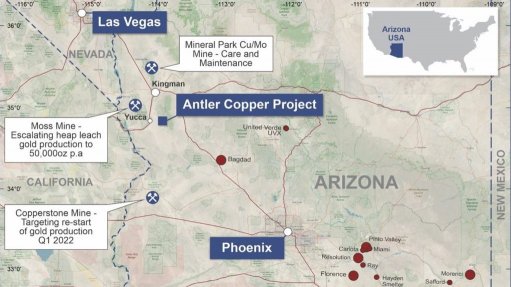Fitch Solutions forecasts higher iron-ore price on the back of strong Chinese demand
Research agency Fitch Solutions Country Risk and Industry Research has revised its iron-ore price forecast for this year higher to an average of $160/t, from its previous forecast of $120/t, as exceptionally strong demand from the Chinese and global steel industry contributed to prices breaking historical records in April.
Since embarking on a longstanding surge in general since mid-2020, prices have yet to show any signs of slowing down and the agency expects this strength to have further room to run before stabilising in the second half of the year.
In the year-to-date figures, iron-ore prices have averaged $162/t and are currently hovering at about $185/t.
Fitch Solutions on May 6 said it believes prices will likely grind lower during the second half of this year as supply improves and demand growth slows.
“We have also raised our 2022 forecast from $100/t to $130/t as prices will start next year from a higher base.”
Since April 2020, growing Chinese demand for iron-ore stemmed from the country's V-shaped economic recovery and the government's major stimulus plan in supporting the construction industry.
This, Fitch Solutions said, would start to produce consolidation towards the second half of this year, especially as the months of April through July usually mark peak seasonal activity for the construction sector.
“We expect the demand impact from stimulus to start wearing off from late 2021 as construction projects reach completion and the pipeline of further new projects lessens, with the Chinese government focusing on tightening credit lines,” Fitch said.
For now, steel production in China is “exceptionally strong”, despite new environmental restrictions shutting some inefficient capacity (for instance, in Tangshan), as large producers that comply with environmental regulations have increased production owing to record-high steel prices and margins.
In the first quarter of this year, steel production growth in China averaged 14.3% year-on-year, compared with 9.7% year-on-year in the first quarter of 2019, and March saw growth of 19.1% year-on-year, a figure not seen since May 2010.
As a result, Fitch Solutions said, China's iron-ore imports reached 284-million tonnes in the first quarter of the year, up 8.1% year-on-year, while the import price averaged $151/t, up 64.5% year-on-year, according to the China Iron and Steel Association.
As steel producers' margins are also at record highs, they are able to accommodate such high iron-ore prices; however, Fitch Solutions believes this will not remain sustainable for long, especially as demand for steel wanes and steel prices ease.
On the supply side, improving production growth from Brazil and Australia will help to loosen tight supplies on the seaborne market, though Vale will take longer to return to capacity levels maintained before the Brumadinho dam collapse.
Persistently weak production from the world’s third-largest iron-ore miner over 2018 to 2020 set the stage for the 2020 price rally, Fitch Solutions added, particularly as Chinese steel producers, who have a growing preference for Brazil's high-grade ore, ramped up production and thus demand for iron-ore.
In its first-quarter report, Vale announced that it was confident of achieving its 2021 iron-ore production guidance of between 315-million and 335-million tonnes, compared with 300-million tonnes in 2020 and 424-million tonnes in 2018.
Vale is working at a current iron-ore production capacity of 327-million tonnes a year.
At the end of 2021, Fitch Solutions expects the company’s production capacity should grow to about 350-million tonnes a year, reaching 400-million tonnes a year at the end of 2022 and 450-million tonnes a year beyond that.
Vale’s first-quarter iron-ore production was 68-million tonnes, 14.2% higher year-on-year.
Meanwhile, in Australia, the above-average wet weather hampered production levels in the first quarter. Among the major producers, BHP produced 59.8-million tonnes and Rio Tinto 76.4-million tonnes of iron-ore during the January to March quarter, flat and down 2% year-on-year, respectively.
“With all miners holding onto production guidances, we expect better quarterly production figures throughout the rest of the year, compared with the first quarter in order to meet targets,” Fitch Solutions said.
LONG-TERM OUTLOOK
Looking beyond this year, Fitch Solutions expects iron-ore prices to follow a multiyear downtrend, and the agency is forecasting prices to decline from an average $160/t this year to $75/t by 2025 and $63/t by 2030.
This price decline will be driven by a combination of weaker demand growth and stronger supply loosening the market. While significantly lower than the $160/t expected this year, the $107/t average that the agency forecast for the 2021 to 2025 period would be higher than the 2016 to 2020 period’s average of $78/t, as a result of starting from a higher base.
Slowing Chinese demand growth will be the main driver of lower prices beyond 2021, and Fitch Solutions anticipates a “reining in” of China's fiscal spending growth from late this year onwards.
“We forecast China’s real gross domestic product growth to slow significantly from 8.5% in 2021 to 5.4% in 2022. The negative impact that this will have on iron-ore demand will be exacerbated by a concurrent shift in government spending away from steel-intensive infrastructure projects and towards a combination of less steel intensive infrastructure and services investment,” the agency said.
These include high-tech infrastructure such as fifth-generation telecoms networks, big data centres, electric vehicle charging stations, industrial Internet, modern transportation such as urban subways and inter-city high speed rail, as well as ultrahigh voltage power-transmission projects.
Consistent with this shift, Fitch Solutions expects an increased focus on green (decarbonised) steel, which requires little to no iron-ore and is produced in electric arc furnaces, compared with the current blast furnace production model that requires iron-ore and coking coal, which is highly polluting.
This structural shift in China’s economic growth trajectory will depress steel consumption and production growth rates, the agency said.
While domestic steel production was allowed to significantly outstrip steel demand over the past decade, with the resulting surplus exported, Fitch Solutions further expects production growth to be brought closer in line with domestic consumption patterns in the coming years.
“We forecast China’s steel consumption growth to slow significantly in 2021 and beyond, following the robust expansion seen in 2020 on the back of infrastructure stimulus. We forecast the country's steel consumption to grow by 2.5% in 2021 and 2% in 2022, compared with 6.5% in 2020 and the 2017 to 2019 average yearly growth of 10.3%.”
With this in mind, Fitch Solutions forecasts steel production and iron-ore demand to grow at a yearly average rate of 1.1% over the 2022 to 2030 period, compared with 5.6% over the 2016 to 2020 period.
Based on these forecasts, the agency expects China’s yearly iron-ore consumption to peak before the end of the decade.
Comments
Press Office
Announcements
What's On
Subscribe to improve your user experience...
Option 1 (equivalent of R125 a month):
Receive a weekly copy of Creamer Media's Engineering News & Mining Weekly magazine
(print copy for those in South Africa and e-magazine for those outside of South Africa)
Receive daily email newsletters
Access to full search results
Access archive of magazine back copies
Access to Projects in Progress
Access to ONE Research Report of your choice in PDF format
Option 2 (equivalent of R375 a month):
All benefits from Option 1
PLUS
Access to Creamer Media's Research Channel Africa for ALL Research Reports, in PDF format, on various industrial and mining sectors
including Electricity; Water; Energy Transition; Hydrogen; Roads, Rail and Ports; Coal; Gold; Platinum; Battery Metals; etc.
Already a subscriber?
Forgotten your password?
Receive weekly copy of Creamer Media's Engineering News & Mining Weekly magazine (print copy for those in South Africa and e-magazine for those outside of South Africa)
➕
Recieve daily email newsletters
➕
Access to full search results
➕
Access archive of magazine back copies
➕
Access to Projects in Progress
➕
Access to ONE Research Report of your choice in PDF format
RESEARCH CHANNEL AFRICA
R4500 (equivalent of R375 a month)
SUBSCRIBEAll benefits from Option 1
➕
Access to Creamer Media's Research Channel Africa for ALL Research Reports on various industrial and mining sectors, in PDF format, including on:
Electricity
➕
Water
➕
Energy Transition
➕
Hydrogen
➕
Roads, Rail and Ports
➕
Coal
➕
Gold
➕
Platinum
➕
Battery Metals
➕
etc.
Receive all benefits from Option 1 or Option 2 delivered to numerous people at your company
➕
Multiple User names and Passwords for simultaneous log-ins
➕
Intranet integration access to all in your organisation


















